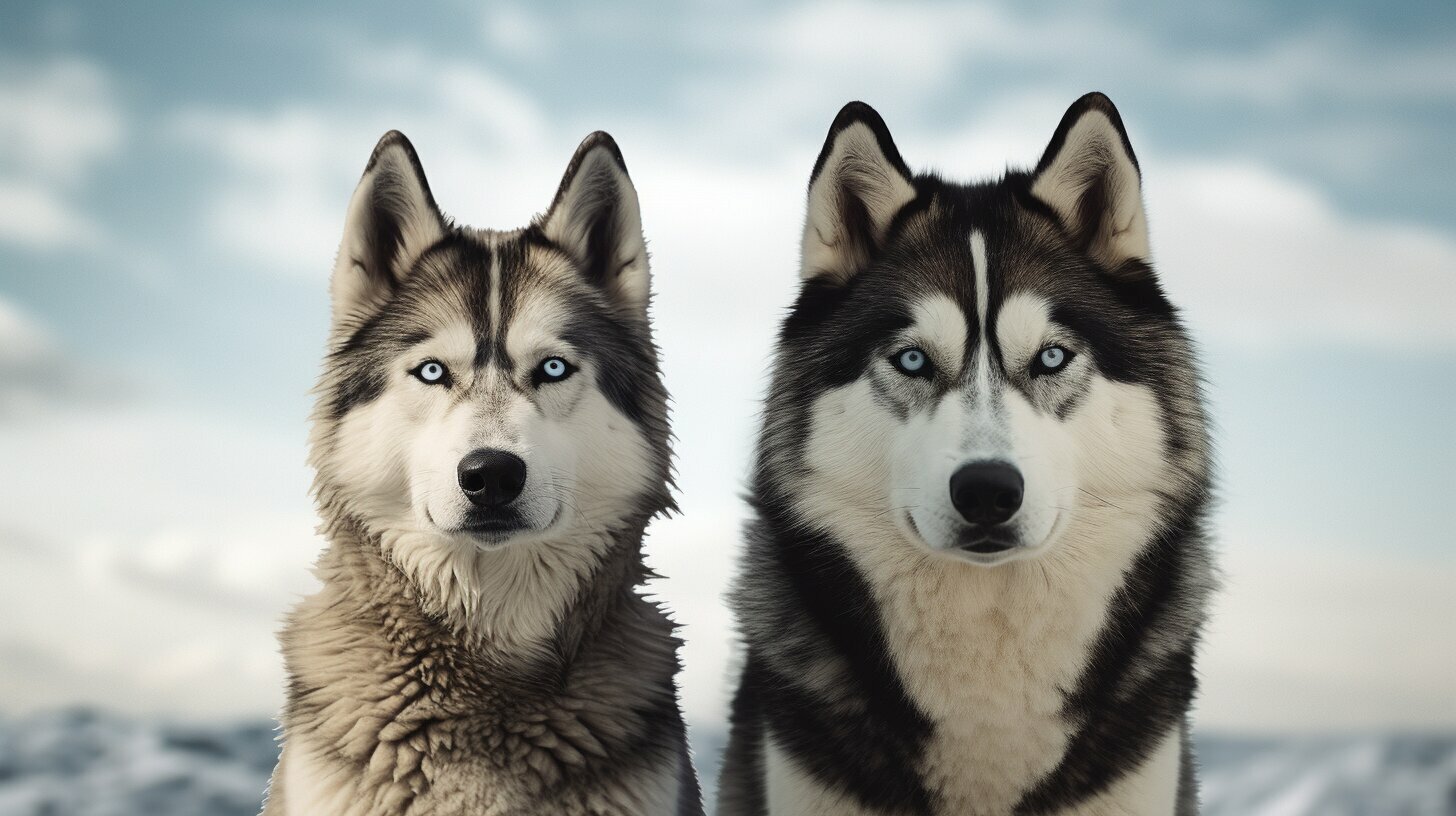The resemblance between huskies and wolves has long fascinated dog enthusiasts and scientists alike. When you see a husky, it’s hard not to notice their striking resemblance to their wild wolf cousins. From their thick fur to their similarly shaped heads, there are undeniable physical similarities between these two majestic creatures.
However, upon closer inspection, there are also significant differences that set huskies apart from wolves. Huskies, although they possess a wolf-like appearance, have smaller frames compared to their wild counterparts. They also have bright blue eyes, which can captivate the hearts of many, and fur that can come in various colors, adding to their unique beauty.
While huskies have evolved into domestic canines, with traits that make them well-suited for human companionship, wolves remain wild animals with characteristics that allow them to thrive in the natural environment. Wolves have larger paws, longer legs, and a more substantial head, coupled with superior intelligence honed for survival in the wild.
In terms of temperament, huskies display a friendly and affectionate nature, making them excellent family pets. They enjoy the company of humans and thrive in social environments. On the other hand, wolves are naturally shy around humans and prefer to keep their distance. It is important to note that the domestication process has significantly influenced the behavior and sociability of huskies compared to their wild relatives.
While the resemblance between huskies and wolves is apparent, it’s essential to recognize that they are not the same. Wolf-dog hybrids, although possible, can be challenging to raise and may pose risks to both humans and other animals. It is crucial to understand and respect the unique needs and characteristics of these animals before considering any hybridization.
Genetic studies have shed light on the origins of huskies and their close ties to their wolf-like ancestors. The breed traces its roots back to the Chukchi Tribe in Siberia, who bred them for their sled-pulling abilities. Furthermore, genetic analysis has revealed that huskies are genetically closer to the Taimyr wolves of Siberia from 35,000 years ago than any other breed of dog.
In conclusion, while huskies may resemble wolves, they are distinct domesticated dogs with their own set of unique characteristics. Their captivating beauty and the allure they hold for many people is a testament to their remarkable breed. By understanding the facts and genetics behind the husky’s resemblance to the wolf, we can better appreciate and cherish the husky’s unique identity as a beloved family pet.
Similarities Between Husky and Wolf: Exploring Physical Traits
When comparing huskies and wolves, it becomes evident that they share several physical similarities. These similarities contribute to the striking resemblance that huskies have to their wild wolf counterparts.
One of the most notable similarities is their thick fur. Both huskies and wolves possess a double coat, consisting of a dense, insulating undercoat and a longer, protective outer coat. This adaptation allows them to withstand harsh climates and cold temperatures.
In addition to their fur, huskies and wolves also have similarly shaped heads. They both have broad skulls and strong jawlines, giving them a distinctive appearance. This shared feature contributes to their wolf-like look and adds to the allure of huskies.
Wolf-Like Features in Huskies
Aside from their fur and head shape, huskies display other wolf-like features. These include their erect ears, almond-shaped eyes, and bushy tails. These features further enhance the resemblance between huskies and wolves, captivating the attention of dog enthusiasts and nature lovers alike.
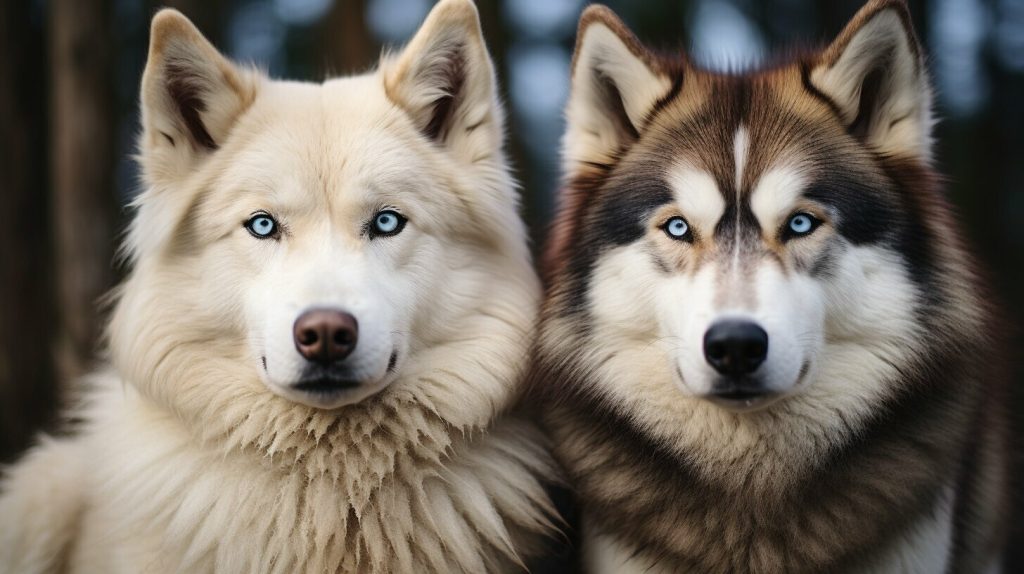
While the physical similarities between huskies and wolves are undeniable, it is important to remember that huskies are domesticated dogs with their own unique characteristics. These similarities are a testament to the close genetic relationship between the two species and highlight the husky’s fascinating evolution from its wolf-like ancestors.
Key Differences: Contrasting Huskies and Wolves
Despite the visual similarities, there are distinct differences that set huskies apart from their wild wolf counterparts. These differences can be observed in various aspects, including size, eye color, fur patterns, temperament, and physical characteristics.
- Size: Huskies are smaller in size compared to wolves. While wolves can grow to be quite large, with an average weight of 70 to 120 pounds, huskies are generally smaller, ranging from 35 to 60 pounds in weight.
- Eye Color: One of the most noticeable differences is in the eye color. Huskies often have stunning bright blue eyes, although other eye colors are possible as well, such as brown, amber, or a combination of colors. In contrast, wolves typically have yellow eyes.
- Fur Patterns: While both huskies and wolves have thick fur, their fur patterns can be quite different. Huskies come in a variety of colors, including black, white, gray, red, and sable, with different markings and patterns. Wolves, on the other hand, generally have a coat that is predominantly gray and white.
Furthermore, wolves have certain physical characteristics that set them apart from huskies. Wolves have larger paws, longer legs, and a larger head compared to the husky breed. These physical attributes contribute to the wolf’s superior agility and intelligence, allowing them to thrive in the wild.
Temperament-wise, huskies are known for their social and affectionate nature. They enjoy being in the company of humans and are generally friendly and outgoing. Wolves, on the other hand, are wild animals and tend to be shy and cautious around humans. Their behaviors and instincts are suited for their natural habitat, and they have not undergone the domestication process like huskies have.
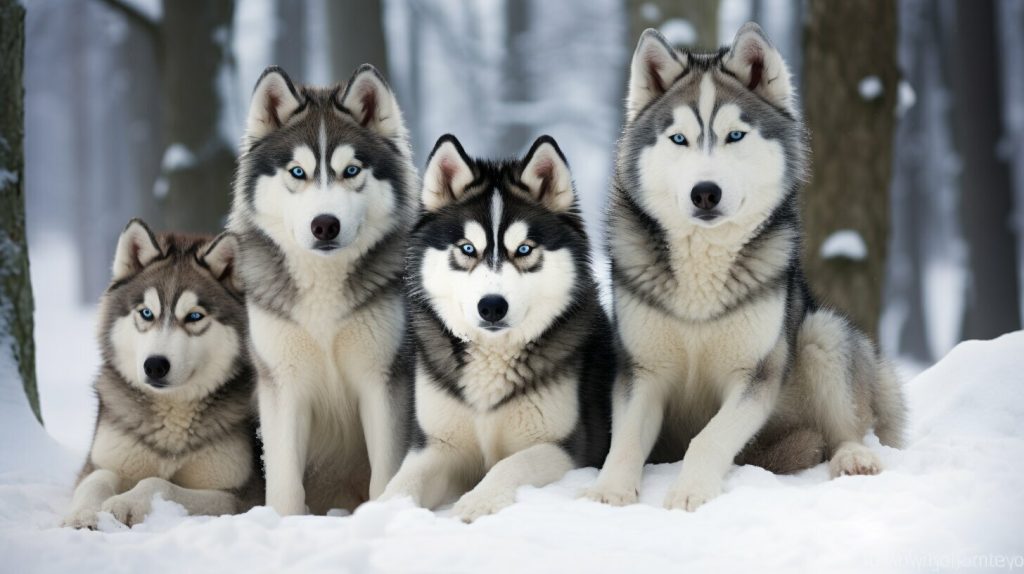
Genetic studies have shown that huskies are genetically closer to their wolf-like roots than any other breed of dog. The husky breed has evolved from their wolf ancestors through a process of selective breeding. They were initially developed by the Chukchi Tribe in Siberia for the purpose of pulling sleds and surviving in harsh Arctic conditions.
Overall, while huskies may resemble wolves in some ways, it is important to recognize that they are still domesticated dogs with their own unique characteristics. As a result of selective breeding and genetic changes over thousands of years, huskies have developed into a distinct breed that is well-suited for companionship and domestic life.
The Evolution of Huskies: Domestication and Genetic Changes
Through centuries of breeding and domestication, huskies have developed distinct traits while retaining their wolf-like genetic heritage. These fascinating canines have undergone a transformation that has enabled them to adapt to human companionship and fulfill specific tasks, such as sled pulling.
Genetic studies have revealed that huskies are genetically closer to their wolf-like ancestors than any other breed of dog. Their genetic ties can be traced back to the Taimyr wolves of Siberia, dating back an impressive 35,000 years. This deep connection explains why huskies share certain physical traits and characteristics with wolves, such as their thick fur and undercoat, as well as their similarly shaped heads.
While huskies may resemble wolves in appearance, there are notable differences between the two. Huskies are smaller in size compared to wolves and possess striking bright blue eyes. They also come in various fur colors, adding to their unique charm. On the other hand, wolves are much larger with yellow eyes and typically have gray and white fur. Wolves also have larger paws, longer legs, and larger heads, demonstrating their superior intelligence and physical capabilities in the wild.
Temperament-wise, huskies thrive in human company and readily display affection towards their owners. They have become well-adapted to living in human households, unlike their wild wolf counterparts, which tend to be more aloof and shy away from human interaction. It’s worth noting that while it’s possible to have wolf-dog hybrids, these animals can be challenging to raise and may pose a potential danger to humans.
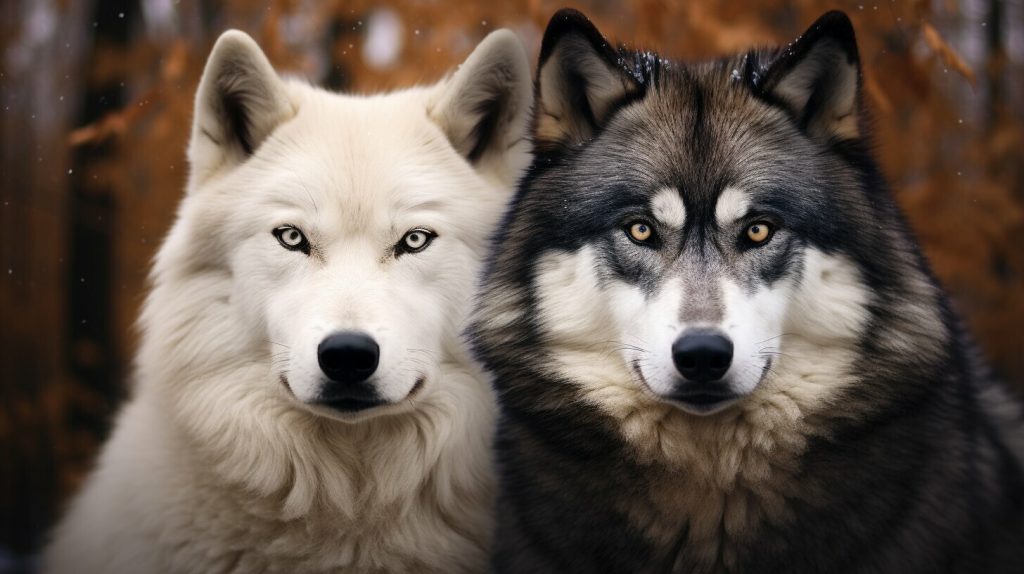
The Chukchi Tribe and the Origins of Huskies
The fascinating history of huskies traces back to the indigenous Chukchi Tribe, where their wolf-like appearance served a practical purpose. These nomadic people, hailing from Siberia, needed a resilient and versatile sled dog to navigate the harsh Arctic terrain. The husky’s striking resemblance to wolves was not accidental; it was a deliberate breeding choice made by the Chukchi Tribe.
Centuries ago, the Chukchi Tribe selectively bred dogs that could withstand the freezing temperatures and be reliable working companions. The Chukchi people understood that dogs with physical traits similar to wolves would possess the stamina, endurance, and adaptability required to pull sleds across vast distances. The husky’s thick fur, undercoat, and sturdy build made them well-suited for the treacherous Arctic environment.
Not only were huskies an integral part of the Chukchi Tribe’s survival, but they also held a significant cultural importance. These dogs were revered as loyal and valued members of the tribe, often living closely with the families and even sleeping beside children to provide warmth. The Chukchi people’s deep bond with their huskies extended beyond utilitarian purposes, creating a unique relationship of mutual trust and companionship.
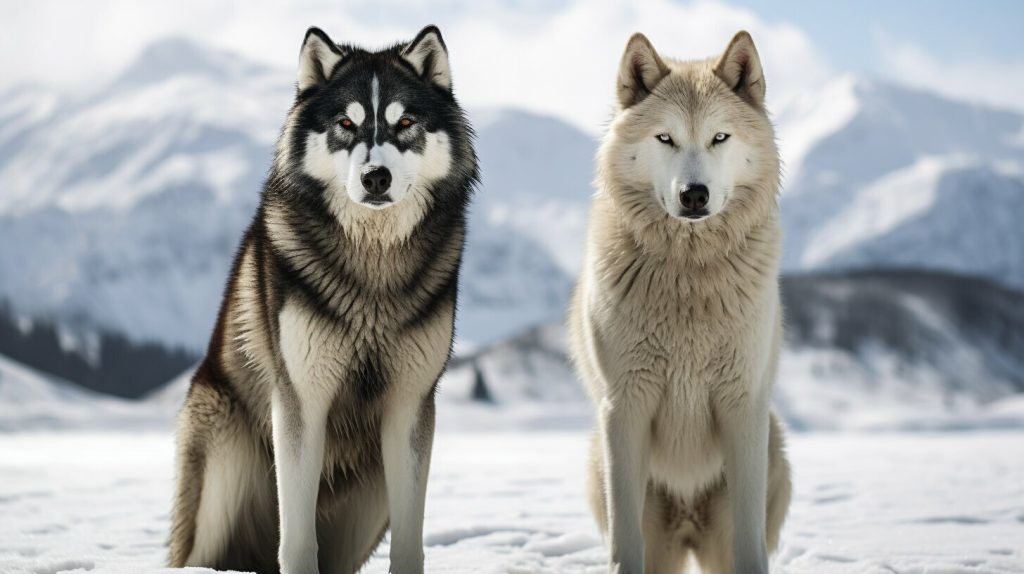
Today, the Chukchi Tribe’s legacy lives on through the Siberian Husky breed. Huskies continue to captivate us with their wolf-like beauty and endearing personalities. While they have evolved into domesticated dogs, their striking resemblance to wolves serves as a reminder of their ancient ancestry and the invaluable contributions they made to the survival of the Chukchi people.
- The husky’s unique appearance, with its thick fur, striking eyes, and proud stance, evokes a sense of wonder and admiration.
- Their gentle and friendly nature, coupled with their intelligence and loyalty, make them beloved companions and family pets.
- Huskies’ genetic closeness to their wolf-like ancestors distinguishes them from other dog breeds, providing insight into their exceptional physical and behavioral traits.
- While they may resemble wolves, huskies are domesticated dogs with their own distinct characteristics, including their need for human companionship and their playful, sociable nature.
So, the next time you encounter a husky with its wolf-like appearance and captivating gaze, remember that behind those piercing eyes lies a rich history of survival, companionship, and a bond between humans and canines that has withstood the test of time.
The Role of Genetics: Unraveling the Ties to Taimyr Wolves
Genetic studies have revealed a deep connection between huskies and the ancient Taimyr wolves from Siberia. These studies have shown that huskies share a significant amount of genetic material with their wolf-like ancestors, dating back thousands of years. The Taimyr wolves, once widespread across Siberia, are believed to be the direct ancestors of modern-day huskies.
Similarities between the huskies and Taimyr wolves can be seen in their physical characteristics. Both possess thick fur and an undercoat, which helps them adapt to cold weather conditions. They also share similarly shaped heads, which contribute to their wolf-like appearance. These shared traits provide evidence of the close genetic relationship between huskies and wolves.
However, there are also distinct differences between the two. Huskies have evolved over time through selective breeding, resulting in their smaller size and bright blue eyes, which can come in various colors. Their fur patterns can vary as well, with combinations of different colors and markings. Wolves, on the other hand, are much larger in size, have yellow eyes, and typically have gray and white fur. They also possess larger paws, longer legs, and a larger head, which contribute to their superior intelligence and survival skills in the wild.
- The genetic closeness between huskies and Taimyr wolves
- The shared physical characteristics of huskies and wolves
- The distinct differences in size, eye color, and fur patterns between huskies and wolves
- The unique genetic traits that have allowed huskies to evolve into domesticated dogs
Overall, the genetic ties between huskies and Taimyr wolves highlight the ancient origins of the husky breed and their close resemblance to their wolf-like ancestors. These genetic roots contribute to the captivating beauty and allure of huskies, while also emphasizing their unique characteristics as domesticated dogs.
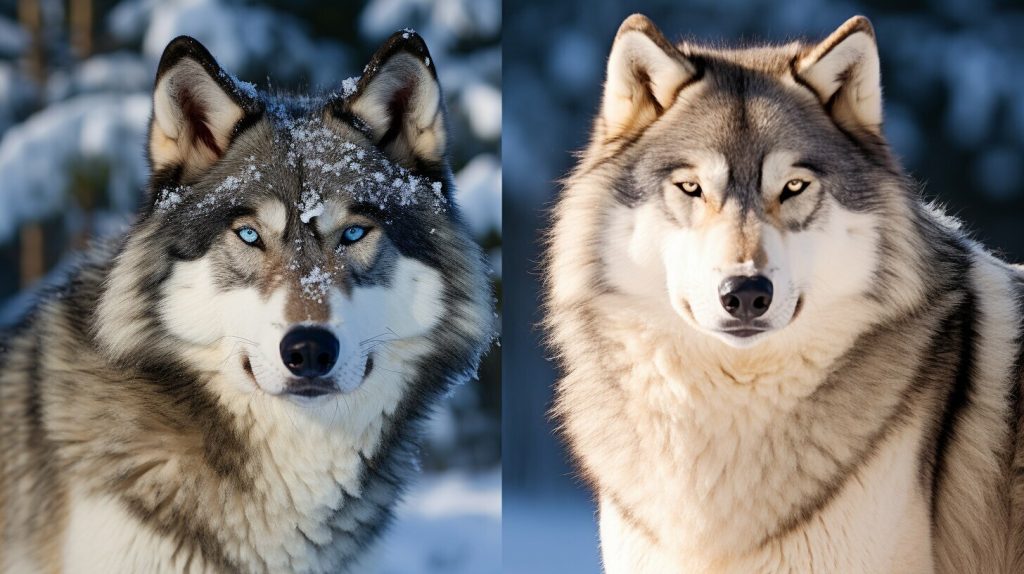
While wolf-dog hybrids can display resemblances to both huskies and wolves, they pose unique challenges and may not be suitable as pets. These hybrids, also known as wolfdogs, are the result of breeding between a domestic dog and a wolf. They can inherit physical traits, such as the thick fur and wolf-like appearance, from their wolf ancestors, but their temperament and behavior can be unpredictable due to the genetic influence of their wild counterparts.
Huskies, with their resemblance to wolves, are sometimes chosen as one of the breeds used in creating wolf-dog hybrids. However, it is important to understand that raising a wolfdog requires expert knowledge and experience. These animals have specific needs and instincts that can prove challenging for even the most dedicated owner.
Some of the difficulties associated with raising wolf-dog hybrids include:
- The need for extensive socialization: Wolf-dog hybrids have a strong instinctual nature and can be aloof or even fearful towards strangers. Proper socialization from a young age is crucial to mitigate aggressive behavior and ensure their safety around unfamiliar people.
- Space and containment requirements: These hybrids have a natural inclination to roam, and they require large, securely fenced areas to fulfill their need for exploration. They are skilled diggers and climbers, making it essential to provide secure containment to prevent escapes.
- Legal restrictions: Wolf-dog hybrids are subject to varying levels of legal restrictions and regulations depending on the jurisdiction. It is essential to research and comply with local laws to ensure the legal and responsible ownership of these animals.
The unique challenges of wolfdog ownership call for responsible breeding practices and informed decision-making.
Considering the potential difficulties associated with raising wolf-dog hybrids, it is crucial to assess one’s capabilities and commitment before embarking on such ownership. Responsible breeding practices that prioritize the health and well-being of these animals are crucial in minimizing potential issues and ensuring suitable homes for the hybrids.
Behavioral Contrasts: Husky’s Affectionate Nature vs. Wolf’s Wild Instincts
Huskies and wolves have significant behavioral differences, with huskies showing a strong inclination towards bonding with humans. This inherent affectionate nature is one of the key reasons why huskies have become popular as family pets. While wolves are wild animals, huskies have been selectively bred for centuries to be companions, resulting in their friendly and sociable behavior towards humans.
Unlike wolves, huskies thrive in human company and form deep emotional connections with their owners. They crave attention and strive to be a part of their human family’s pack. Whether it’s snuggling up on the couch, wagging their tails in excitement, or showering their loved ones with slobbery kisses, huskies are known for their unwavering loyalty and affection.
Another contrast in temperament between huskies and wolves lies in their response to unfamiliar situations. Huskies are highly adaptable and tend to be more tolerant and accepting of new environments, people, and animals. In contrast, wolves are typically cautious and exhibit a strong instinctual fear of the unfamiliar. This difference in behavior stems from the domestication process that huskies have undergone, which has shaped them into being more sociable and less fearful.
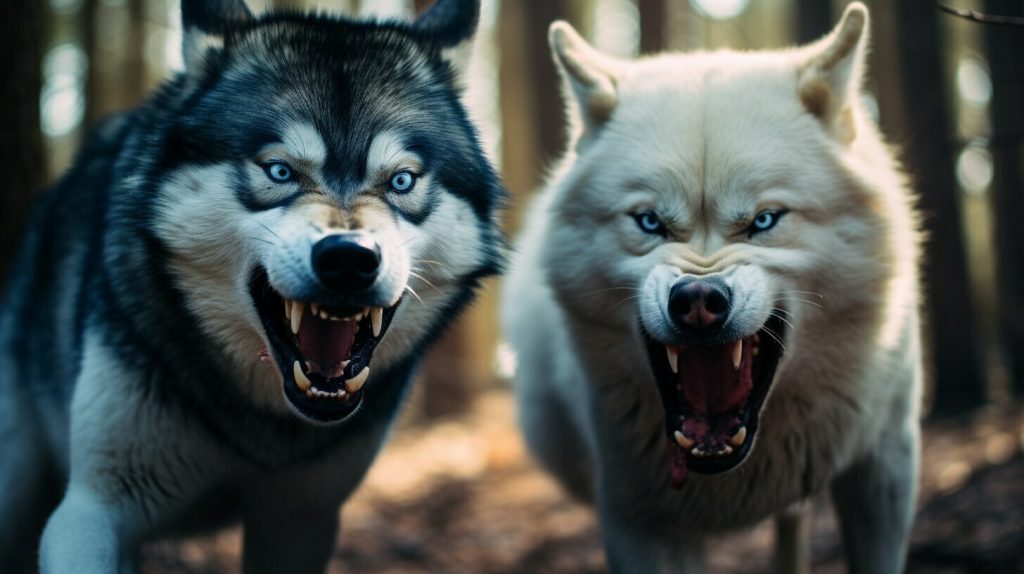
- Huskies possess a captivating beauty with their piercing blue eyes, striking facial markings, and luxurious coats.
- The allure of wolves lies in their untamed, mysterious nature, symbolizing strength and freedom.
- Both huskies and wolves evoke a sense of admiration and awe, each in their own unique way.
In conclusion, while huskies may share some visual similarities with wolves, their behavior sets them apart as distinct domesticated dogs. Their affectionate nature, adaptability, and sociability make them incredible companions and cherished family pets. Understanding the behavioral contrasts between huskies and wolves helps us appreciate the unique qualities that make huskies so beloved by dog enthusiasts around the world.
The Significance of Husky’s Unique Characteristics
Huskies possess distinct traits that have been selectively bred over time, shaping them into the lovable, loyal companions they are today. These unique characteristics set them apart from other breeds and contribute to their enduring popularity as pets. Here are some of the key traits that make Huskies truly one-of-a-kind:
- Beautiful and Resilient Fur: The Husky’s double-layered coat is designed to withstand harsh Arctic conditions. The outer layer is composed of long, water-resistant guard hairs, while the dense undercoat provides insulation, keeping them warm in cold temperatures. This combination of fur not only gives them their distinctive appearance but also makes them well-equipped for braving cold climates.
- Exceptional Stamina and Endurance: Huskies are renowned for their endurance and strength. Bred for sled-pulling, they possess remarkable stamina and can maintain a steady pace over long distances. This makes them ideal partners for outdoor enthusiasts and active individuals who enjoy hiking, jogging, or other outdoor activities.
- Gentle and Social Nature: Despite their wolf-like appearance, Huskies have a naturally friendly and gentle disposition. They are known for their sociable nature and enjoy the company of both humans and other dogs. Their affectionate temperament makes them great family pets and gives them a strong bond with their owners.
Drive and Intelligence:
In addition to these characteristics, Huskies are highly intelligent and possess a strong sense of independence. This intelligence, combined with their natural drive to explore and work, requires mental stimulation and regular exercise to keep them engaged and content. They thrive in an environment that challenges their minds and gives them a sense of purpose.
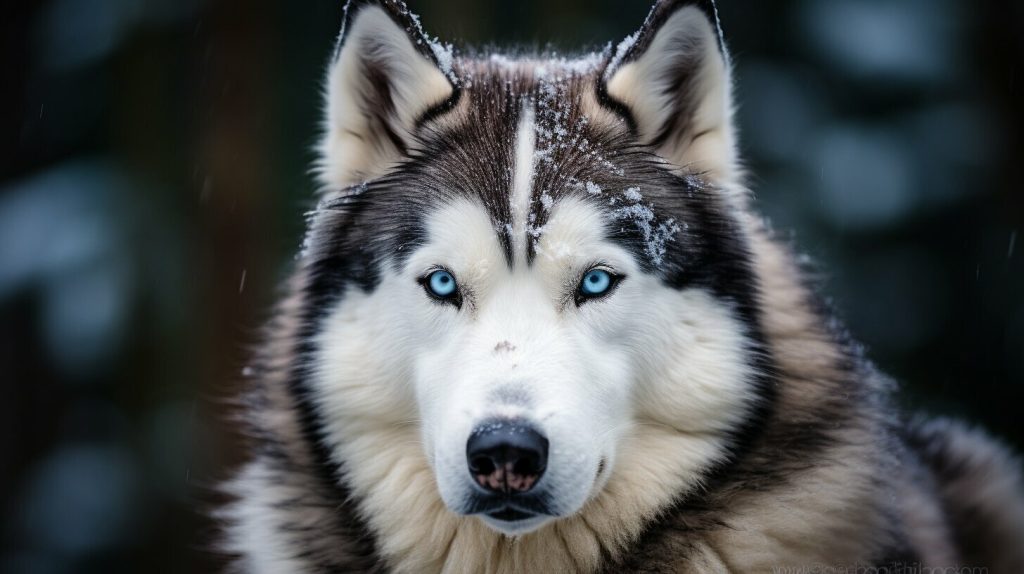
The husky’s unique traits and physical features make them truly captivating animals. From their enchanting eyes to their gorgeous coat, they exude an enigmatic beauty that is hard to resist. Their resemblance to wolves adds to their allure, evoking a sense of mystery and wildness. However, it’s important to remember that despite their wolf-like appearance, huskies are domesticated dogs with their own distinct traits and characteristics. They have been bred and refined over generations to be loyal, loving companions, and their unique qualities make them ideal pets for those who appreciate their beauty, intelligence, and affectionate nature.
Appreciating the Enigmatic Beauty: The Allure of Huskies and Wolves
The striking appearance of huskies and wolves captivates the hearts and minds of people around the world. These majestic creatures possess a captivating beauty that is both fascinating and alluring. With their piercing eyes, thick fur, and graceful movements, huskies and wolves command attention and leave a lasting impression.
One cannot help but be drawn to the wild and untamed aura that surrounds these animals. Their resemblance to one another only adds to their enigmatic allure. As one gazes into the bright blue eyes of a husky, or the piercing yellow eyes of a wolf, it is impossible not to be captivated by the intensity and depth that lies within.
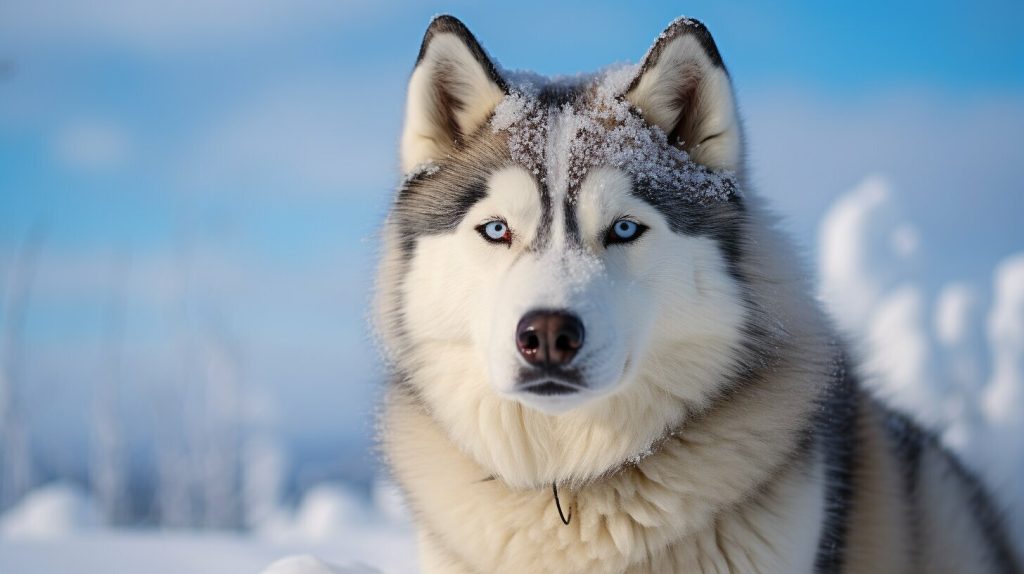
The Unique Characteristics of Huskies and Wolves
- Huskies: These domesticated canines have evolved to be smaller in size than their wolf counterparts. Their bright blue eyes and diverse range of fur colors, from pure white to striking copper, only add to their charm. Their friendly and outgoing nature makes them excellent companions.
- Wolves: These magnificent creatures are larger in size, possessing an unmatched strength and power. With their intelligent eyes and beautifully patterned gray and white fur, wolves exhibit an undeniable grace that demands respect. Their wild instincts and shyness towards humans add to their aura of mystery.
Despite their similarities in appearance, huskies and wolves have distinct differences that set them apart. These differences are a testament to the unique journey that huskies have taken from their wolf-like ancestors. While huskies may bear the physical resemblance to wolves, they have undergone genetic changes and domestication that make them distinct and well-suited for life as beloved pets.
So, whether you find yourself captivated by the captivating beauty of a husky or the untamed allure of a wolf, there is no denying the enchantment that these animals hold. Their striking appearance and unique characteristics continue to inspire and fascinate us, reminding us of the beauty and diversity of the animal kingdom.
Conclusion: Embracing the Husky’s Unique Identity
While Huskies may bear a resemblance to wolves, they are a distinct and treasured breed with their own set of characteristics and qualities. Their thick fur, undercoat, and similarly shaped heads showcase similarities with their wild counterparts. However, there are notable differences that set them apart.
Huskies have evolved into domesticated canines, making them well-suited for companionship and life with humans. Their smaller size, bright blue eyes, and fur that can come in various colors add to their unique charm. In contrast, wolves are much larger, with yellow eyes and generally gray and white fur. Their larger paws, longer legs, and larger heads, combined with their superior intelligence, equip them for survival in the wild.
Temperament-wise, Huskies thrive in human company and display a remarkable affectionate nature. They form strong bonds with their families and enjoy being a part of the pack. On the other hand, wolves are wild animals that are naturally shy around humans and prefer to maintain their distance.
It is worth noting that while it is possible to have wolf-dog hybrids, raising them can be challenging and may pose risks to both humans and the animals themselves. Genetic studies have revealed that Huskies are genetically closer to their wolf-like roots than any other breed of dog. Their origins can be traced back to the Chukchi Tribe in Siberia, who bred them for their exceptional sled-pulling abilities. Additionally, the genetic connection between Huskies and the Taimyr wolves of Siberia from 35,000 years ago further highlights their unique heritage.
In conclusion, while Huskies may bear a resemblance to wolves, they are a breed with their own distinct identity. Their genetics, temperament, and purpose in human society separate them from their wild ancestors. Huskies are cherished companions, valued for their loyalty, affection, and stunning appearance. Their enigmatic beauty captivates many, making them a beloved and treasured breed in their own right.
FAQ
Why do huskies resemble wolves?
Huskies resemble wolves due to their shared physical traits, such as thick fur and similarly shaped heads. However, huskies have been domesticated and have unique characteristics that differentiate them from wolves.
What are the similarities between huskies and wolves?
Huskies and wolves share physical traits such as their thick fur and similarly shaped heads. They also have an undercoat that helps them insulate in cold weather.
What are the key differences between huskies and wolves?
Huskies are smaller in size compared to wolves and have bright blue eyes, while wolves are larger with yellow eyes. Huskies come in various fur colors, whereas gray and white are typical colors for wolves. Wolves also have larger paws, longer legs, and a larger head with superior intelligence.
How are huskies genetically related to wolves?
Genetic studies have shown that huskies are genetically closer to their wolf-like ancestors than any other breed of dog. Their genetic roots can be traced back to the Taimyr wolves of Siberia from 35,000 years ago.
Where did huskies originate from?
Huskies originated from the Chukchi Tribe in Siberia. They were originally bred for pulling sleds and were highly valued for their endurance and ability to thrive in harsh Arctic conditions.
Can huskies and wolves interbreed?
It is possible to have wolf-dog hybrids, but they can be difficult to raise and may pose a danger to humans. The complex nature of their genetics can result in unpredictable behaviors and challenges in their upbringing.
What are the temperamental differences between huskies and wolves?
Huskies thrive in human company and show affection, while wolves are wild and shy away from humans. Huskies have been domesticated over generations, leading to their social nature, whereas wolves retain their instinctual behavior in the wild.
What makes huskies unique compared to wolves?
Huskies have evolved through domestication and possess characteristics unsuited for the wild. They have been selectively bred for specific traits and have adapted well to living with humans. Their unique characteristics make them suitable as companion animals.
Why are huskies and wolves admired for their beauty?
Both huskies and wolves possess a captivating beauty that many people find alluring. Their resemblance to each other, with their striking eyes and majestic presence, adds to their appeal.
